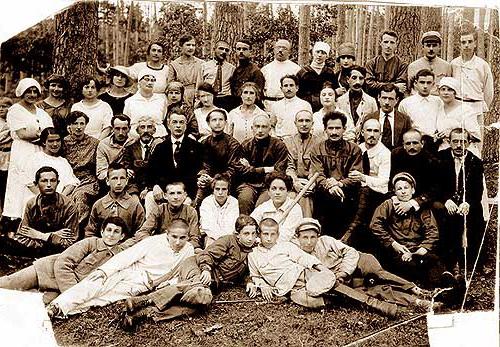What you can eat during gastritis. Slimy rice soup with parsley. Fully or partially restricted products.
Menus for acute gastritis
The stomach is the first organ in which digestion of food occurs. In this organ, food is processed by gastric juice, softened and partially broken down into simpler elements, and then enters the intestines. Any abnormalities in the stomach can lead to serious health problems. The most common disease of the stomach is gastritis. This ailment can occur in acute and chronic form, and acute gastritis is considered the most difficult regarding symptoms and treatment.
The stomach can never calm down, even if it is sick. Therefore, it is all the more important not to expect too much during a sharp push. The mucous substances contained in it help protect the stomach from inflammation. If the disease disappears again, you can feed according to the rules of balanced mixed foods: fruits, vegetables, whole grains and potatoes, then define a booklet. The more nutritious food, the easier it becomes for the stomach to process it. In addition, solid foods should be carefully digested: enzymes contained in saliva are already involved in digestion in the mouth.
With gastritis, the diet is part of a comprehensive treatment.
Along with conservative treatment with medications, and in especially severe cases, with surgical intervention, dietary nutrition is an integral part of the treatment of acute gastritis.
Features of acute gastritis
Acute gastritis is an inflammation of the mucous membrane that occurs for the first time. This type of disease is characterized by severe symptoms and relatively severe course. Patients complain of nausea and vomiting, belching, upset stools, bloating and sharp pains in the projection of the stomach.
Frequent food intake is especially important for gastritis. When food enters the stomach slowly and well, it absorbs it better. During an acute shock, it is best to take 4 to 6 small meals a day - when the inflammation subsides, you can reduce it to 3 to 5 again.
Fasting can work wonders
Food is best served warm. Spicy and fatty dishes are taboo for gastritis. To inappropriate food products include meat, raw sausage, full-fat milk and dairy products, mayonnaise and fat-containing sauces. When acute gastritis irritation is noticeable, you should consider fasting treatment. This makes a perfect stomach easier, and at best it is a noticeable improvement in only one to two days. During this time, you still drink mineral water, herbal teas and clean, low-fat vegetable soup.
Depending on what caused the inflammation - an error in nutrition, overeating, nervous shocks, getting into gastrointestinal tract acids or alkalis - there are several subspecies of gastritis. The simplest of them - catarrhal, does not pose a threat to the patient's life, while necrotic and phlegmic gastritis can lead to death if untreated.
Too much hunger can be blocked, if necessary, with soup with oatmeal and crackers, which should be chewed well. For maximum effect and in order to avoid a lack of nutrition, the scheduled fasting should be discussed with your doctor.
Acid Disease
Can the correct result in calculating complaints? Gastritis is an inflammation of the gastric mucosa. In acute gastritis, patients often have a stomachache, suffer from bloating and bloating. Nausea and vomiting are often present, while in a chronic illness there are usually no symptoms or only mild symptoms.
 Some types of gastritis develop as a result of poor diet
Some types of gastritis develop as a result of poor diet The basic rules of clinical nutrition for acute gastritis
A classic healthy diet for acute gastritis implies a maximum reduction in the amount of irritating substances in food, as well as a decrease in the load on the digestive tract as a whole. At the same time, the nutritional value of the food consumed should cover the minimum needs of the body. Of considerable importance is the regulation of the acidity of the digestive juices, the protection of the damaged mucosa from the negative effects.
Ayurvedic diet for gastritis to soothe the stomach
According to Ayurvedic doctrine, gastritis occurs due to too a large number Pitta, that is, too much fire in the body. To balance Pitt again, the body must be transcendentally cooled, and the stomach must be calmed.
According to Ayurveda, there are certain herbal remedies that support the gastric mucosa, so that their infected areas can be cured. In addition, there are special products that provide a protective layer on the mucous membrane of the stomach, so this time it is necessary to regenerate and in the future is not so susceptible. For example, parsets have such a protective effect.
Highlights on nutrition for gastritis in the acute stage:
- fractional nutrition - small portions, up to 100 ml, but you need to eat at least 6 times a day;
- food temperature - at the level of the patient’s body temperature, in no case is it hot or cold;
- in the first week, eating only grated food;
- refusal to drink with food and a few minutes before it - the minimum interval between drinking and eating should be 60 minutes.
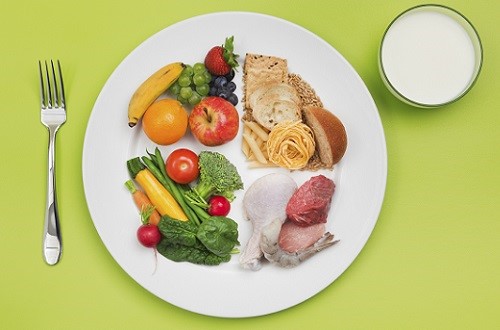 If a person has gastritis, he should eat regularly and in small portions.
If a person has gastritis, he should eat regularly and in small portions. Another rule that patients often forget about is thoroughly chewing food, even if it is chopped with a blender. At the stage of processing in the mouth, the food lump should be thoroughly mixed with saliva. This will allow nutrients to be absorbed faster and more fully.
Medications often only help temporarily. Changing the diet for gastritis can lead to permanent relief. Drugs, such as acid blockers, are one of the most commonly used remedies in our culture. However, consumers often report this phenomenon that they only help briefly and return the initial symptoms. In addition, bloating, belching and flatulence may occur in us.
When gastritis in the diet, avoid harmful foods
Stomach problems, such as inflammation of the gastric mucosa, are extremely unpleasant. But what is such gastritis, and how do you get rid of them? Read important information about the development and treatment of stomach ailments. Gastritis occurs when the protective layer is attacked inside the stomach and cannot work properly. This layer is located in a thin film above the gastric mucosa and protects the stomach from its aggressive acidity. According to the pharmacy review magazine, the protective film can be attacked for completely different reasons - for example, bacteria or unfavorable, for example, too sharp foods, nicotine, coffee or alcohol, or various.
With gastritis in the acute stage, a gradual expansion of the diet is very important - starvation on the first day after the onset of symptoms of the disease with a gradual expansion of the diet, which consists of allowed foods and dishes.
What to eat with acute gastritis - a list of allowed foods
The list of allowed foods for gastritis depends on the subspecies of the disease. In gastritis with high acidity, it is necessary by adjusting the diet to reduce the secretory activity of the gastric mucosa, while with low acidity, on the contrary, it is necessary to activate the work of the glands in the stomach. That is why the diet for acute gastritis with different levels of Ph gastric juice is different.
Fruits and berries
Painkillers are a particularly common potential trigger for gastritis. Various rheumatoid drugs, as well as drugs administered during chemotherapy, can cause inflammation of the gastric mucosa. In addition, psychological or physical can lead to stomach disease.
Different types of inflammation of the gastric mucosa
There are various forms of gastritis. First, a distinction is made between acute and chronic infections of the gastric mucosa: the acute form begins very suddenly and usually heals again as quickly. The chronic form, on the other hand, is usually very long and is often associated with less severe symptoms.
| Types of allowed products (by groups) | In acute gastritis with high Ph | In acute gastritis low Ph |
|---|---|---|
| Bread, Baking | Stale bread, rolls, pies or cookies made from non-butter and not puff pastry, dry biscuit. | White bread crackers. |
| Meat products | Lean beef (minced meat), chicken or turkey (minced meat, steam cooking). | Low-fat sausages and ham, beef, low-fat pork, meat broths. |
| Fish products | River and marine low-fat fish (minced meat, steaming). | River and sea fish, preferably not oily, fish stock. |
| Dairy products | Milk, mild cheese. | Adyghe cheese, cottage cheese, skim milk, kefir or fermented baked milk. |
| Cereals | Buckwheat, semolina, millet, oatmeal. | Pasta, buckwheat, oatmeal, semolina, millet, corn grits. |
| Vegetables | Everything except legumes, tomatoes and white cabbage. | All types of cabbage, root vegetables, leafy greens. |
| Fruits | Apples (baked or mashed), persimmons, bananas, watermelon, cherries and other stone fruits in the form of jelly, compotes and jelly. | Fruits and berries without a dense skin. |
| The drinks | Kissel, tea is not strong, coffee drink, fruit and vegetable juice, water without gas. | Juices from fruits and vegetables, tea, jelly, coffee drink, cocoa, slightly sparkling water. |
In gastritis with low acidity, the menus are designed in such a way that the dishes are as aromatic and appetizing looking as possible - this will contribute to better excretion of gastric juice. In addition, after mitigating the symptoms, it is not recommended to cook minced meat dishes. It is better to cook it by roasting or on charcoal, so that each piece of such food can be chewed for a long time, which, again, improves appetite and promotes the production of gastric juice.
Typical symptoms of inflammation of the gastric mucosa
It is usually caused by bacteria. Finally, type C can be caused by various substances, such as drugs. Acute inflammation of the gastric mucosa is usually accompanied by typical symptoms that often require treatment. Common complaints are, for example, stomach pain. It can either be pulling or pushing nature. And also a feeling of fullness is also often observed in victims.
On the other hand, the chronic form is accompanied by much milder symptoms, often not affected. Possible complaints can be, like a complete feeling. Possible complications of chronic inflammation of the gastric mucosa without treatment, however, are, for example, stomach ulcers, in very rare cases, even cancer of the stomach.
A little different is the case with acute gastritis with high acidity. Here, the task of nutrition is not only to reduce the synthesis of hydrochloric acid, but also to neutralize it during digestion. In this case, the menu consists mainly of mashed dishes and minced meat and fish. It also helps to quickly cure some forms of the disease, for example, erosive gastritis, due to the pronounced enveloping effect of food.
Do households help against gastritis?
Symptoms of inflammation of the gastric mucosa can often be treated very effectively with various symptoms. Especially simple home remedies are a hot water bottle or a cereal pillow that fits on your stomach or stomach: the heat relaxes and can help lighten or spread. Many sufferers also had good experiences with various herbal teas: a particularly sweet tooth is suitable for treating stomach problems.
Drink it sparingly, as it can increase blood pressure. Dill and chamomile tea should also soothe the stomach. Finally, you can also make flaxseed mucus for processing: boil a tablespoon of flaxseed for about half an hour in 4 liter water. Remove the mucus from the resulting mass and take a small amount of it daily. Mucus is deposited as a protective layer over the gastric mucosa.
What you can not eat with acute gastritis
In the acute form of inflammation of the gastric mucosa, it is not recommended to include excessively coarse, fatty and acidic foods in the nutrition plan. So, at any level of acidity of the gastric juice, you can not eat the following foods:
Nutrition for gastritis as a diet
In case of inflammation of the gastric mucosa, it is important to strain the stomach as little as possible. That is, eat as little food as possible to avoid too much acid in the stomach. Do not use too hot or too cold servings. Chew food more often than in perfect condition. As a gastropod, you will find mainly vegetables such as fennel, carrots, green salad, zucchini or green peas. Serve potatoes, mashed potatoes or rice.
For a little hunger, acid fruits, such as apples, pears, peaches, grapes, bananas and melons, are taken between you at best. Since the recommended foods are especially light and fat-free with gastritis, they have a similar effect on the diet.
- pickled, salted and pickled vegetables and fruits;
- salted, smoked, dried and canned meat and fish products;
- complex soups, which include fried dressing with tomatoes, onions, garlic and spices;
- spicy vegetables - radish, radish, garlic;
- vegetables, fruits and herbs with a high acid content - sorrel, spinach, pomegranates, citrus fruits;
- fatty meats and fish;
- freshly baked bread and pastries, puff pastries and pastries with fat cream;
- frying vegetables, meat and fish.
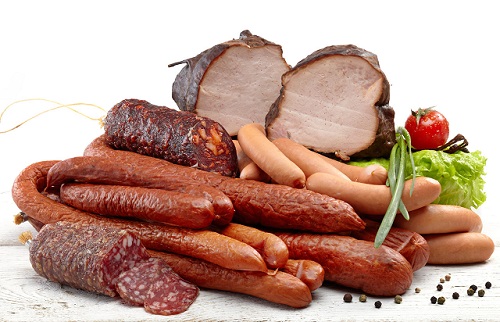 In acute gastritis, smoked foods are prohibited
In acute gastritis, smoked foods are prohibited Alcoholic beverages, strong teas, strong coffee also fall under the ban (instant coffee is especially dangerous for the stomach).
Give your stomach a chance to recover. Therefore, do not eat fat, fry, fry or smoke. Less suitable foods include bread and pastries, nuts, citrus fruits, avocados, fatty dairy products, flowering vegetables, and spicy spices. Drinks should also be careful: coffee, alcohol, soda, and black tea are prohibited.
Fasting as a treatment for gastric mucosal infections
Often with acute gastritis, several days of fasting are prescribed, which helps to soothe the mucous membrane of the stomach. Do not just stick to solid foods during this time - even sweets such as alcohol, coffee or nicotine should be taboo. Instead, drink plenty of water or herbal teas.
Sample menu
In the first days after exacerbation of gastritis, you can eat only weak tea, preferably herbal tea, a decoction of non-acidic berries and a mucous decoction of rice, oats or flax seeds. On the second day, if the symptoms ceased to be severe, it is recommended to gradually introduce mashed soups and milk porridges, meat and fish meals, depending on the patient’s appetite.
After about one to two days, your stomach trouble has often improved so much that you can stop fasting. Subsequently, however, you should not immediately return to the old menu - you must take several days to eat. Suitable products here are marinade made from oatmeal and water as the only ingredients, mashed potatoes without hot spices or crackers. After a few days, you are again allowed to consume a light mass: not to refuse a digestible.
What is dangerous gastritis?
Keep in mind that the mucous membrane of the stomach can be chronic and can cause serious damage to the body. Therefore, always discuss with your doctor if possible treatment in self-regulation. If you suffer from an acute form, your family doctor may prescribe in addition to nutritional discomfort or a strict dietary supplement. Often this is a medicine that reduces or inhibits acid production. Also, medications that curb nausea and vomiting lead to greater well-being.
Sample menu per day is as follows:
- Breakfast - porridge mucous from rice or oatmeal, tea with milk.
- Lunch - mashed cottage cheese with the addition of banana, a little sour juice.
- Lunch - mashed soup on vegetable or meat broth (depending on the acidity of the gastric juice), buckwheat meatballs with meat, dried fruit compote.
- Snack - a fresh banana or a baked apple.
- Steamed vegetables with fish, fruit and berry jelly.
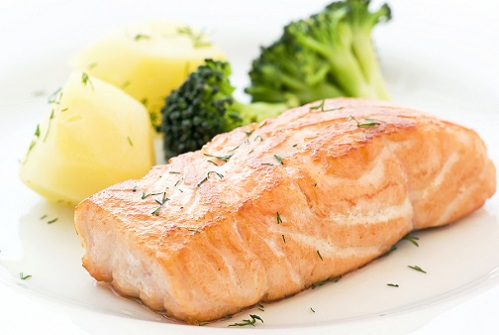 Steamed dishes are preferred
Steamed dishes are preferred Before going to bed, you can eat a little cottage cheese, a baked apple or half a banana. Between meals, you must drink mineral water (preferably without gas) or herbal teas.
If your doctor has diagnosed a chronic form of the gastric mucosa, he will prescribe medication based on the type of gastritis. In the case of type C, the gastrointestinal substances must be constantly eliminated as necessary, and medical blocking acids may also be useful. Acne, bronchitis, osteoporosis, multiple sclerosis, hypertension, dementia or cancer - hundreds of diseases are associated with chronic inflammation. Chronic high levels of stress, food allergies, smoking, and environmental pollutants can cause inflammation in the body.
It is very important that the patient, no matter what type and type of gastritis he is diagnosed with, does not feel hunger.
As the patient's condition improves even further, it is recommended to add mashed soups, steam cutlets, meatballs and meatballs, vegetable salads (first from boiled, and then raw vegetables), casseroles from cereals and pasta , stew and dumplings.
However, nutrition should play an important role in chronic inflammatory processes. With these ten foods, you can prevent inflammation and support healing. Inflammation is not as bad as their reputation: the process of inflammation is a natural reaction of the body to defend against intrusions and pollutants. The blood circulation of the affected area is initially throttled to soon receive an increased amount of blood.
Cereals and cereals from them
Thus, fresh white blood cells, our body defense cells, reach the inflammatory heart. Inflammation, therefore, is one of the most important body functions that keep us healthy. Only if the immune system it reacts too sharply and starts attacking also healthy body tissue, diseases arise. Acute inflammation, such as sinuses, appendix or bladder, can be quickly diagnosed and treated.
It is necessary to adhere to a diet not less than three months. During this time, the mucous membrane of the stomach will be finally restored, and the risk of chronic gastritis will significantly decrease.
In the form, the doctor will tell about gastritis:
Categories: /
One of the most common diseases of the digestive system is gastritis. This disease affects about 10% of the total population of the planet.
For the treatment of gastritis, certain medications are prescribed, but without following a diet, getting rid of this disease will not work. Therefore, each patient should study the list of products that must be excluded from their diet.
The right approach to diet
Before creating a menu you need to find out what your gastritis is: with high or low acidity. Indeed, many products affect the production of secretions, as well as the motility of the digestive tract.
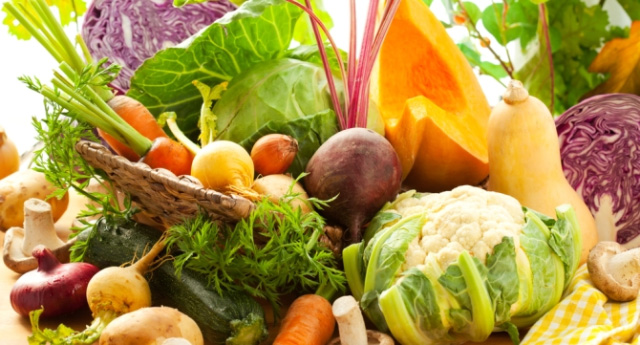
But still there are certain rules of the diet, which should be observed regardless of acidity:
- The day should start with breakfast.
- It is necessary to observe 3-4 hour breaks between meals. Shorter intervals will lead to overeating, and longer ones will lead to an increase in the concentration of hydrochloric acid.
- Food should be taken in small portions, preferably at the same time.
- Chew your food well. This will help the stomach to cope with its task.
- You can drink drinks (water, tea) no earlier than 30-35 minutes after eating.
- It is not recommended to eat on the go or “dry”.
- Salty, fatty, smoked and spicy dishes are prohibited.
- It is necessary to exclude alcohol, drinks with gas and sugar, coffee.
- Your menu must be made only from fresh and high-quality products.
What you can not eat with gastritis with high acidity
If this form of the disease is observed, then in your menu you can not include products that provoke the production of hydrochloric acid, as well as increase gastric motility. It is better to cook dishes that are not irritating to the mucous membranes.
List of foods not to eat:
- Porridge from millet or pearl barley;
- Rye, bran or fresh, still warm bread and baking;
- Various greens: spinach, dill, onions, garlic, sorrel;
- Meat of fatty, hard or sinewy varieties;
- Any beans (beans, peas, lentils);
- Sunflower seeds and any nuts;
- Cabbage;
- Mayonnaise, ketchup;
- Sour cream, kefir, fermented baked milk, cream;
- Citruses
- Sour fruit;
- Soups and borscht cooked in fatty broths;
- Mushrooms;
- Fried eggs;
- Sausages, jerky, canned food;
- Cakes and cakes.
- Salty fish.
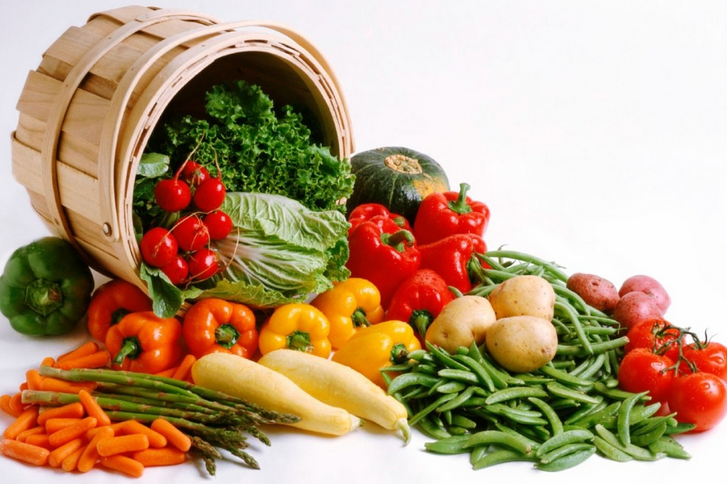
Why should be abandoned with low acidity
If this form of the disease is observed, then you need to stimulate the production of gastric secretions. Therefore, it is necessary to eat dishes that accelerate this process, and, in addition, increase appetite. Indeed, most patients suffering from this form of the disease complain of its absence. You can help your body if you watch a movie about mouth-watering dishes before eating, or try to fantasize about delicious food. Thus, your stomach will begin to produce more juice.
What can not be eaten with this form of the disease:
- Rough food. The stomach is quite difficult to cope with such products. Therefore, limit your intake of cereals from pearl barley or wheat grits, as well as beans.
- Hard meat
- Fast food and canned fast food;
- Thick pasta;
- Fried eggs with fried eggs;
- Fresh bread, loaf, rolls;
- Animal fats;
- Seasonings and spice mixtures;
- Confectionery, ice cream;
- Drinks with gas, kvass;
- Raspberries, gooseberries, currants;
- Dried fruits;
- Grape Juice.

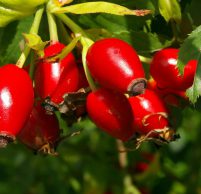
Increased acidity. Menu Rules
Having seen the number of foods that should be excluded with this form of the disease, you will undoubtedly ask: what is allowed to eat in this case? Do not be afraid that you will have to starve. Indeed, from the products that you can safely add to your menu, you will prepare many tasty and healthy dishes that help reduce the concentration of secretions of gastric juice, and enhance the natural defense of the digestive system.
What to eat:
- Yesterday’s white bread, crackers, and dietary cookies are allowed.
- You can eat oatmeal, as well as "mucous" porridge from buckwheat and rice. If you want to improve the taste of such dishes, you can add one or two tablespoons of milk at the end of cooking.
- Potatoes, carrots, beets, cauliflower. However, do not eat vegetables without prior processing. They must be baked, cooked, and can be in a double boiler. Sometimes it is allowed to afford a little tomato without a peel.
- Bananas, sweet berries, non-sour varieties of apples and pears - permitted fruits, but do not get involved in them. Remember that the main rule of nutrition with this ailment is moderation. You can eat fruits and berries only in a crushed form.
- You can cook yourself an omelet, or boil a soft-boiled egg. But remember that your norm is one per day.
- Dairy products boost hydrochloric acid production, so in your case, adding them to the diet should be with extreme caution. Sometimes you can use a little skim milk or sour cream. Cottage cheese is an excellent product, but only in processed form, so make casseroles or soufflé from it, but in no case cheesecakes.
- Butter and vegetable oil can be added to dishes, but only a little.
- If you want to cook a meat dish, then only low-fat diet varieties are suitable for you: lamb, turkey, rabbit, chicken breast.
- Fish it is better to choose low-fat varieties: cod, pollock, hake, blue whiting, pollock.
- If you want sweets, you can sometimes indulge yourself with marshmallows, milk cream, pastille, jelly, soufflé and honey.
- Of the drinks, it is better to choose various jelly and fruit drinks, you can also drink alkaline water without gas and weak tea. Freshly squeezed carrot, potato and cabbage juice help with this form of the disease. Rosehip infusion will also be very useful.
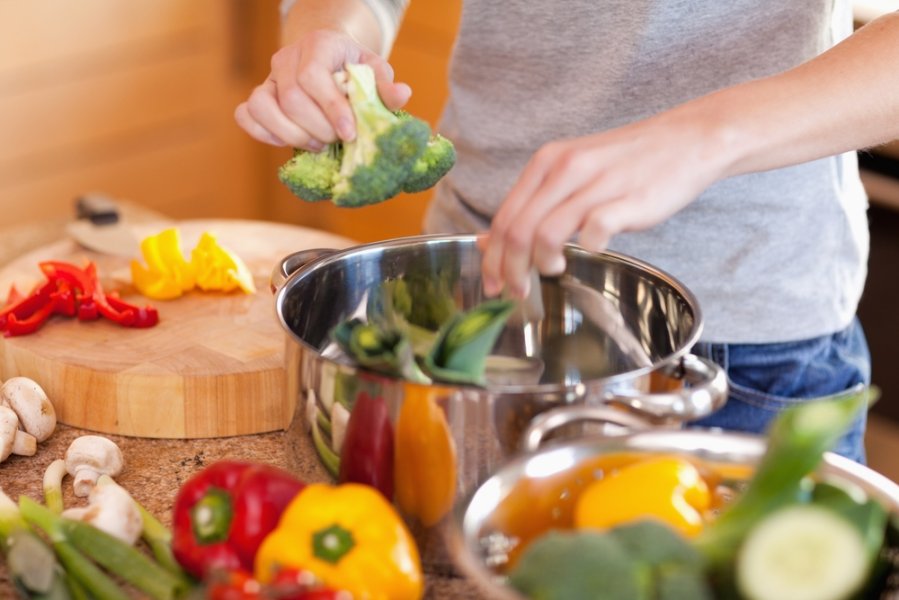
Low acidity. What can I eat
- It is allowed to use a small amount of white "yesterday" bread.
- It is allowed to eat semolina, buckwheat and rice porridge, cooked without the addition of milk or cream.
- You can add potatoes, zucchini, cabbage, pumpkin to the menu. But no matter which vegetable you choose, it should be boiled or steamed.
- Of the fruits, you decide to eat sour varieties of apples, watermelon, cranberries, black currants.
- You can eat no more than 2-3 eggs per week, cooked in the form of an omelet or soft-boiled.
- It is recommended to use kefir, yogurt, cottage cheese, yogurt daily. Pure milk is acceptable only as an additive to tea or coffee.
- In this case, it is better to give preference to marine species of fish. It is sometimes allowed to treat yourself to slightly salted herring.
- When cooking meat dishes, preference should be given to dietary varieties: chicken, turkey, rabbit. These products can be boiled or steamed. It is sometimes allowed to eat meat baked in a sleeve, but only without “crusts”. You can also eat broths with the addition of cereals or pasta.
- It is recommended to drink weak tea with a slice of lemon. You can also occasionally drink weak coffee and cocoa. It is useful to add juice from carrots, potatoes, cabbage to your menu.

Menu
A seven-day diet should be made up on the basis of a diet called the “Table No. 1”. Such nutrition is recommended for exacerbations, as well as gastric and duodenal ulcers. All dishes on the menu should be boiled or cooked in a double boiler. Power scheme:
- First breakfast. For this meal, you can cook an omelet, pudding, porridge or cottage cheese casserole.
- Snack. At this time, you can use milk soup, mashed potatoes, steamed meat tunes, or baked fruits.
- Dinner. Soup is a must for this meal. For the second, you can make a dish of meat or fish. Dessert is a small cup of jelly or fruit jelly.
- Snack. At this meal, you can eat a plate of jelly, or drink a cup of tea with a slice of marshmallow or marshmallow.
- Dinner. An excellent choice is porridge or mashed vegetables. You can also diversify this meal with meat or fish cakes cooked in a double boiler. If desired, you can replace these dishes with soufflé, puddings, jelly.
- Last meal (2 hours before bedtime). You should use kefir if you have low acidity. When elevated, it is allowed to eat a small portion of baked fruit.




